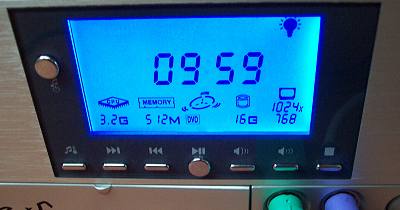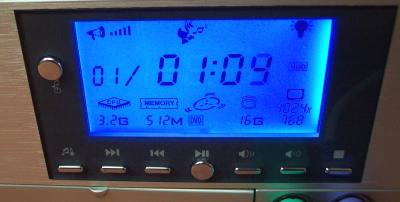The front
The Mini Me arrived well packaged. The chance of transit damage is low.
After removing the protective inserts and whipping off the polythene bag, the eX5-300S in all its silvery glory. The front is plastic but gives off the look of aluminium. The plastic mirror-finished sides provide a hi-tech look. The floppy drive has been left out of the eX5-300S' design thoughts. Instead, a multicard reader that offers support for all the usual suspects takes its place. EPoX's thoughts about a SFF system are clear. It needs to be small, modern and have enough connectivity appeal to satiate most users.
The 5.25" bay uses a flip-down cover to obscure the drive's fascia. We like that, there's nothing worse, in style terms, than a mismatched optical drive front and SFF fascia. The two silver buttons have extended plastic sections on the other side. This allows them to push the correct button on the drive's fascia. We found them to be sensibly located. Both buttons worked correctly on 2 DVD-ROM drives.

We'll come to the intriguing LCD display in a moment. EPoX chooses to mount the PS/2 ports on the front. There's also no method of covering them, unlike the other high-speed ports on the left. From a purely style point of view, we'd prefer the legacy ports on the back, out of the way. If the user opts for, say, a USB-powered keyboard and mouse combination, the PS/2 ports will remain visible.
High-speed connectivity is what we've become accustomed to. 2x USB2.0 and a single FireWire port is the norm for most SFF systems. Headphone and microphone sockets complete the lineup. Another pulldown flap that would have hidden the PS/2 ports would have been a good aesthetic idea.
We first saw a front-mounted LCD screen on the ABIT DigiDice. It's a good idea, as most SFF systems will be housed on the desk, in direct view of the user. We're surprised that Shuttle hasn't thought of this feature before.

The LCD display works in one of two ways. Assuming that a playlist has been entered in an OS environment or a music CD is present, the eX5-300S has a Music On-Now feature that allows for the playback of music files, be they on the hard drive, USB flash disk or CD, without the need for booting into the OS. The screen shows a MiniOS (pseudo operating system) from which tracks can be chosen. Pretty neat.

In an OS environment the display provides plenty of useful information. CPU speed, RAM size, hard drive space, resolution, temperature and volume levels being the most noticeable. It's bright, clear, and easy to read. The LCD time is automatically taken from the OS settings. What at first looks like a gimmick is, in reality, quite a decent tool.
We're pretty impressed with the front. Let's take a look at the back.









